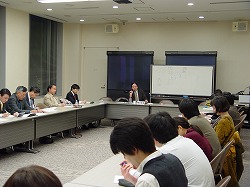2008 Lecture Series , Number Two
“Is the Concept of‘Aoshio Cultural Studies’Feasible”
Professor AKASAKA Norio (Tohoku University of Art & Design)
Data May 14, 2008 18:30-20:30
Place Ichigaya Campus, Hosei University


“The Potential for Aoshio Cultural Studies”
Professor AKASAKA Norio is Director of the Graduate School, Tohoku University of Art & Design, Director of the university,s Tohhoku Culture Research Center, and Director of the Fukushima Museum. As a pioneer of Tohoku Studies, he has developed the field of“Aoshio cultural studies,”which was originally proposed by Professor ICHIKAWA Takeo. The field of Kuroshio ‘( Black Current’) cultural studies is well known. The field of Aoshio ‘( Blue Current’) cultural studies, on the other hand, is the not-so-well studied route of cultural dissemination along the Tsushima Current and the Liman Current, which flow between the Eurasian continent and the Japanese islands.
The Aoshio perspective on cultural dissemination argues that cultural elements and vegetation, such as ama divers, ika(squid) shrines, camellia japonica, beech trees, the hoof-cultivation
method and red rice, have disseminated along the Aoshio currents from the Japanese islands into Cheju Island (Korea) to form a cultural region. Professor Akasaka argues that Aoshio culture has also contributed to the development of To-hoku culture in the northeastern regions of mainland Japan. Aoshio culture is indicative of the diversity of Japanese culture, and further it has spread into East Asia to form part of its cultural melange.
Professor Akasaka has also followed the research of YANAGITA Kunio (1875-1962), the pioneer of Japanese native ethnology, and has questioned its potential and limitations. Yanagita identified
jo-min (common folk), rice cultivation and ancestral worship as forming the core of Japanese folk culture. His folklore studies are often criticized as having formed a“one-state folklore,”an
intellectual process of creating the concept of“one Japan”under the name of folklore. However arguments that supported the“one Japan”theory—such as the island-country state theory, the centralism of rice cultivation culture, and the monoethnic state—are no longer effective today, and a new vision of a diverse Japan is needed.


